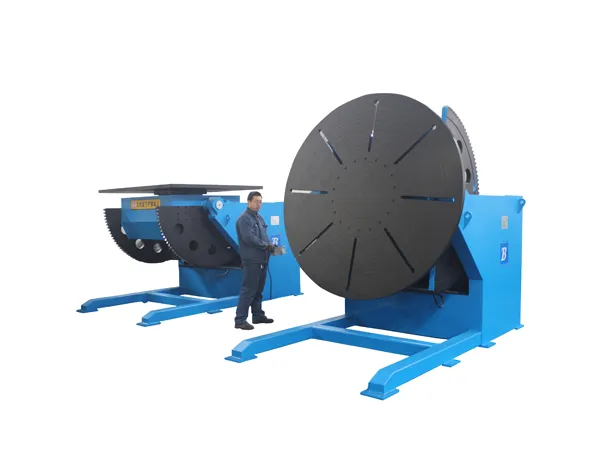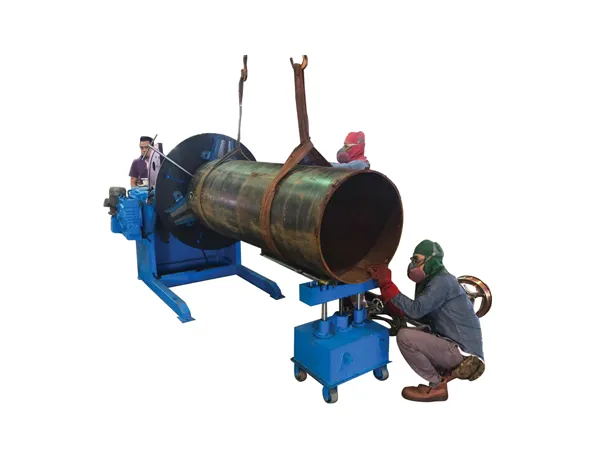Welding positioners are crucial pieces of equipment in fabrication and welding shops, designed to hold and manipulate workpieces, allowing welders to achieve optimal positions for welding. Understanding their load capacity is essential for safe and efficient operation.

Welding positioner load capacity refers to the maximum weight and associated forces a positioner can safely handle while rotating and tilting a workpiece. It's not just about the raw weight; it's a combination of the workpiece's weight and its center of gravity (CG).Manufacturers typically specify load capacity on a "capacity plate" or in the equipment's documentation. This often includes:
Maximum Weight Capacity: The absolute maximum weight the positioner can hold.
Tilt Torque Load: The maximum rotational force the positioner can handle when tilting the workpiece.
Rotation Torque Load: The maximum rotational force the positioner can handle when rotating the workpiece.
Center of Gravity (CG) Distance: This is critical. The further the workpiece's CG is from the positioner's table surface (for tilt) or the center of the table (for rotation), the greater the torque applied to the positioner, even with the same weight.
The load capacity is heavily influenced by the torque exerted by the workpiece on the positioner's mechanisms (motor, gears, bearings). Torque is a twisting force, calculated as:
Torque = Weight × Distance
Here's how this applies to positioners:
Determine the total weight of the weldment: This includes the workpiece itself, any fixtures, chucks, or tooling attached to it.
Calculate the Center of Gravity (CG) of the work:
Distance from the face of the table (for tilt torque): This is the perpendicular distance from the table surface to the workpiece's CG.
Distance from the rotational center of the table (for rotation torque, also known as eccentricity): This is the parallel distance from the center of the table to the workpiece's CG. For asymmetrical workpieces, this is crucial.
Inherent Overhang: Positioners have an "inherent overhang," which is the distance from the tilting pivot point of the table to the surface of the table. This distance must be added when calculating tilt torque.
Rotation Torque Load = Weight of workpiece (lbs) × Eccentricity distance (inches)
Tilt Torque Load = Weight of workpiece (lbs) × (CG distance from table face (inches) + Inherent Overhang (inches))
Compare with Positioner Specifications: The calculated rotational and tilt torques must be less than or equal to the maximum rotational and tilt torque ratings of the chosen welding positioner.
Example:If a positioner is rated for 40,000 lbs (18,140 kg) with a CG at 12 inches (300 mm) from the table, it means that this combination of weight and CG is the maximum it can handle for tilt. If you have a lighter workpiece but its CG is much further out, it could exceed the positioner's torque capacity even if the raw weight is within limits.

Several factors influence the actual load a welding positioner can safely handle:
Weight of the Workpiece and Fixtures:
The most obvious factor. The heavier the combined load, the greater the demand on the positioner.
Center of Gravity (CG) Location: As explained above, the further the CG is from the positioner's axes of rotation and tilt, the higher the torque, and thus the lower the effective weight capacity. An off-center load dramatically increases the stress on the positioner's components.
Eccentricity: How far the CG is offset from the center of rotation for rotational movements.
Inherent Overhang: A fixed distance specific to each positioner model that contributes to the tilt torque calculationDesign and Construction of the Positioner:
Motor Power and Torque: The motor must be powerful enough to rotate and tilt the loaded workpiece smoothly.
Gearbox and Drive System: These components transmit power from the motor to the table and must be robust enough to handle the applied torques.
Bearings and Spindle Stiffness: These support the weight and rotational forces.
Base Stability: A stable and properly anchored base prevents tipping, especially with heavy or off-center loads.
Table Size and Configuration: A larger table can sometimes distribute the load better, but it also influences the distances to the CG.
Dynamic vs. Static Loads: The listed capacity is usually for static loads. Dynamic forces (like sudden starts or stops, or unbalanced rotation) can momentarily exceed static ratings, so it's good practice to have a buffer.

Operational Speed: Operating a positioner at higher speeds with heavy or unbalanced loads can increase wear and stress on the components.
Mounting and Fixturing: How securely and centrally the workpiece is mounted to the positioner's table impacts stability and load distribution. Proper fixturing is crucial to prevent movement or shifting during operation.
Condition and Maintenance: A well-maintained positioner with lubricated gears and healthy bearings will perform closer to its rated capacity than a poorly maintained one.
In summary, selecting the right welding positioner involves more than just matching the workpiece weight to a listed capacity. It requires a thorough understanding of the workpiece's geometry and center of gravity to ensure that the positioner can handle both the weight and the resulting rotational and tilting torques safely and efficiently. It's always better to err on the side of caution and choose a positioner with a capacity slightly exceeding your maximum anticipated needs, as consistently loading a positioner to its absolute limit can reduce its lifespan.
No. 1 Intersection of Chuangye Avenue and Weilai Avenue,
Yiyang County,Luoyang City, Henan Province, China
+86 400-0379-069
Copyright © 2023 An Automated Welding and Cutting Equipment Manufacturer Focusing on Welding Column Boom and Welding Rotator | All Rights Reserved Technical support: ShangXian